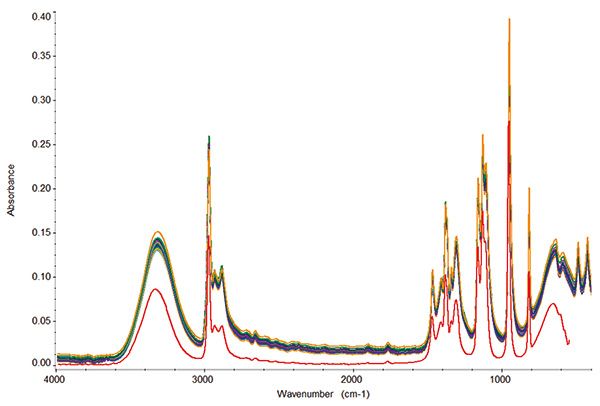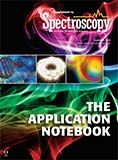Automated ATR for High-Throughput Laboratories
Application Notebook
Using an automated ATR accessory, mid-infrared spectra were collected on 24 individual ATR crystals. Spectra were compared to a spectrum collected using a single bounce diamond ATR crystal. Advantages of implementing automated measurements and benefits of automation in laboratory environments are discussed.
ATR is one of the most popular mid-infrared sampling techniques because minimal to no sample preparation is required due to the short effective pathlength. Until now, automating ATR methods to improve workflow in high-throughput laboratories has been elusive because of the typical need to clean and dry the ATR sampling surface in between each measurement. By taking advantage of unique Si wafers functionalized with multiple microprisms optimized to perform as ATR elements, ATR automation is available as a commercial macroscale accessory. This application note explores automated ATR measurements in the evaluation of an organic solvent.
Experimental conditions
The model sample was propanol-2. Using the AutoATR Accessory by PIKE Technologies, a microtiter style platform for automated ATR measurements, 24 unique sample measurements were made on individual ATR crystals from IRUBIS GmbH. The accessory is suitable for measuring liquids, gels, pastes, and casted films. The AutoATR stage is controlled and data collection is initialized by PIKE AutoPRO7 software. Spectra collected with the AutoATR were compared with a single reflection diamond ATR. Spectral resolution was 8 cm-1 and 16 scans were co-added. Before the automated sample measurements an individual background was acquired for each well.
Results
The AutoATR uses 24 unique Si ATR elements, which have a thickness of 500 microns. Due to the thin profile of the crystal, the absorbance from Si phonon bands is minimal relative to thicker traditional Si ATR crystals. This allows the entire mid-IR spectral range to be accessed from 5000–400 cm-1. Si has an extremely inert sampling surface and is suitable for use with substances having a pH between 1–12. The efficiency of the accessory's base optics and Si ATR element coupled with several microprisms results in high energy throughput and reproducibility.
Figure 1 shows 24 individual spectra of propanol-2 and a comparison spectrum collected using the PIKE MIRacle single reflection diamond ATR. Spectra collected with the AutoATR were exceptionally reproducible. In the fingerprint region the variance was less than 0.007 AU (no baseline correction implemented). Relative to a single reflection diamond ATR, the absorbance bands were almost two times stronger when collected with the AutoATR. Thus, this accessory will result in higher signal-to-noise ratio and greater sensitivity.

Figure 1: 24 individual ATR spectra of propanol-2 collected using the AutoATR and a spectrum collected with the MIRacle single reflection diamond ATR (red) for comparison.
The AutoATR high-throughput accessory is ideal for comprehensive larger studies. Fields of biology, medicine, pharmaceutics, and food could benefit from an automated ATR. Additionally, there are ongoing efforts to transfer infrared spectroscopy from academic research into clinics. An automated ATR device fulfills this requirement and enables larger studies, while increasing lab efficiency and minimizing workforce requirements.
Conclusion
New innovations in ATR elements in conjunction with an automated optical platform has made automated ATR measurements possible. Using the AutoATR, spectral results are more sensitive than a typical single reflection ATR.

PIKE Technologies, Inc.
6125 Cottonwood Drive, Madison, WI 53719
tel. (608) 274-2721
Website: www.piketech.com
